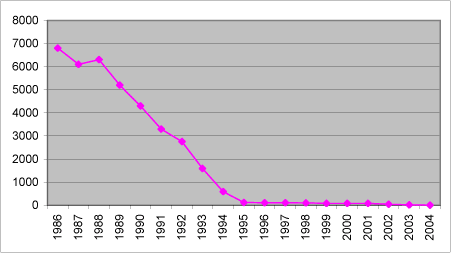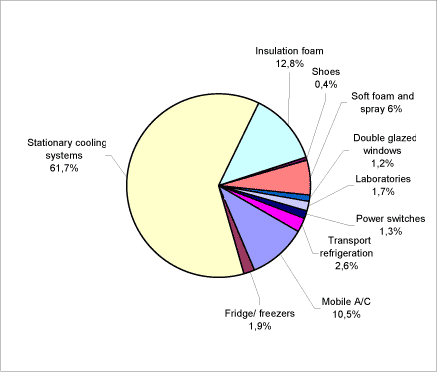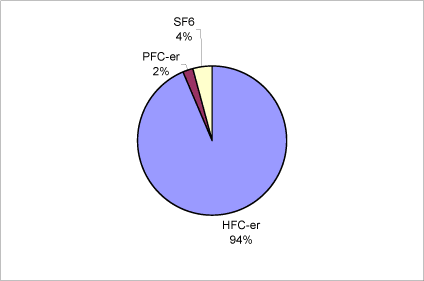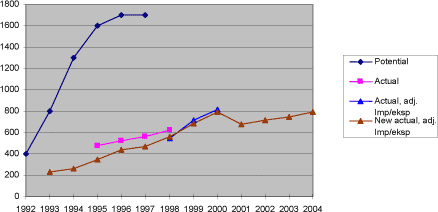|
| Front page | | Contents | | Previous | | Next |
Ozone-depleting substances and the greenhouse gases HFCs, PFCs and SF6
1 Summary
1.1 Ozone-depleting substances
ODP-weighted consumption for 2004 has been calculated at 2.83 ODP tonnes, a further reduction of 14.53 ODP tonnes compared to 2003, when consumption was 17,36 ODP tonnes.
The table below shows ODP-weighted consumption calculated on the basis of information on imports from importers and producers. The ODP values are listed in Appendix 1, Table 1.a.
Table 1.1 Overview of consumption and ODP-weighted consumption in 2002-2004, Tonnes
| Substance |
Net consump-
tion, 2002 |
ODP-weighted consump-
tion, 2002 |
Net consump-
tion, 2003 |
ODP-weighted consump-
tion, 2003 |
Net consump-
tion, 2004 |
ODP-weighted consump-
tion, 2004 |
| CFCs (1) |
0.95 |
0.76 |
0.1 |
0.08 |
0.01 |
- |
| Tetrachloro-methane |
0.87 |
0.96 |
0.36 |
0.39 |
0.033 |
0.036- |
| 1,1,1-Trichloroethane |
0.02 |
- |
0.02 |
- |
0.009 |
- |
| Halons |
0 |
0 |
0 |
0 |
0 |
0 |
| Methyl bromide |
(only feedstock) |
- |
(only feedstock) |
- |
- |
- |
HCFCs
HCFC-22 (new)
HCFC-22
(regenerated)
HCFC-22 (HFC mix)
HCFC-123
HCFC-141b
HCFC-142b |
390
24.5
-
-
-
-
360
0 |
41.25
1.35
-
-
-
-
39.6
0 |
204.65
96,7
-
-
-
-
102.35
0 |
16.88
5.3
-
-
-
-
11.26
0 |
142.68
0
112.1
10.3
-
-
20.28
0 |
2.79
0
0
0.56
-
-
2.23
0 |
| Total |
|
42.97 |
|
17.36 |
|
2.83 |
(1) In the calculation of the ODP-weighted consumption of CFCs, CFC-113 is the only substance which has been reported and which is included in the calculation basis.
Danish consumption of methyl bromide has only been used as feedstock for other chemical production. Therefore it is not included as an emission.
CFCs, tetrachloromethane, and trichloroethane are used exclusively for laboratory purposes.
HCFCs are used as refrigerants or for foam production (system foam). The areas of application of HCFCs in 2004 are shown in Table 1.2.
Table 1.2 Consumption of HCFCs by application area in 2004, tonnes.
| Application area |
HCFC-22 |
HCFC-123 |
HCFC-141b |
HCFC-142b |
| System foam (for panels, insulation, etc.) |
0 |
0 |
20,28 |
0 |
| Refrigerants, New |
0 |
0 |
0 |
0 |
| Refrigerants, regenerated |
112,1 |
0 |
0 |
0 |
| Refrigerants, HFC mixtures |
10,3 |
0 |
0 |
0 |
| Total |
122,4 |
0 |
20,28 |
0 |
Only regenerated HCFC-22 is used as a refrigerant in Denmark and import of new HCFC 22 is exported to other countries for use as refrigerant. Regenerated HCFC 22 is not included in calculation of the
ODP weighted consumption.
HCFC-141b is used in foam production

Figure 1.1 The development of ODP-weighted consumption 1986-2004, tonnes.
The specific consumption figures for individual substances and groups of substances and the ODP contribution calculated for the period 1992-2004 appear in Table 3.1 in Chapter 3.
1.2 F-gases
The GWP-weighted actual emissions of HFCs, PFCs, and SF6 in 2004 were 796.8 thousand tonnes CO2 equivalents. The corresponding emissions were 745.6 thousand tonnes CO2 equivalents in 2003,
as reported in /13/.
Emissions of HFCs, PFCs, and SF6 in 2003 contributed about 1 per cent of the total Danish GWP contribution /21/. The formal 2004 inventory has not been completed yet while comparison has not been
made.
In Table 1.3 below, consumption, actual emissions and stock in products are summarised after making adjustments for any imports and exports of stock in products.
Table 1.3 Consumption, actual emissions, stock, adjusted for imports/exports as well as GWP contribution from greenhouse gases 2004, tonnes.
| Source |
Substance |
Consump-
tion and
imports, DK,
tonnes |
Stock,
tonnes |
Actual
emis-
sions,
tonnes |
GWP
contribution,
CO2 eqv. tonnes |
GWP
contribution in
total, CO2 eqv.
tonnes |
| Refrigerants for commercial stationary refrigerators and A/C systems |
HFC-134a |
154.5 |
806.1 |
75.0 |
97466 |
|
| |
HFC-404a |
240.3 |
1008.9 |
89.4 |
291434 |
|
| |
HFC-401a |
0.0 |
20.3 |
2.5 |
46 |
|
| |
HFC-402a |
0.0 |
28.0 |
3.2 |
5430 |
|
| |
HFC-407c |
101.3 |
353.3 |
29.7 |
45269 |
|
| |
HFC-507a |
10.6 |
61.8 |
5.9 |
18184 |
|
| |
Other HFCs |
16.2 |
104.8 |
10.3 |
17768 |
|
| |
PFCs |
0.3 |
19.8 |
2.3 |
15902 |
|
| |
All substances |
|
|
|
|
491498 |
Household fridges/freezers
Refrigerants |
HFC-134a |
83.2 |
797.2 |
9.3 |
12108 |
|
| |
HFC-404a |
6.1 |
77.0 |
0.9 |
2834 |
|
| Insulation foam |
HFC-134 |
0.8 |
1303.4 |
78.2 |
101619 |
|
| |
HFC-152 |
0.0 |
2.4 |
0.1 |
16 |
|
| |
All substances |
|
|
|
|
116577 |
| Refrigerants for mobile A/C systems |
HFC-134a |
32.4 |
211.2 |
64.3 |
83639 |
83639 |
| Refrigerated vans and lorries |
HFC-134a |
0.6 |
6.3 |
1.2 |
1560 |
|
| |
HFC-404a |
6.2 |
32.0 |
5.7 |
18453 |
|
| |
HFC-402a |
0.0 |
1.8 |
0.4 |
650 |
|
| |
All substances |
|
|
|
|
20663 |
| Other PUR foam |
HFC-134a/245 |
8.5 |
0.3 |
2.4 |
3171 |
3171 |
| Soft foam and aerosol sprays etc. |
HFC-134a |
35.8 |
|
36.4 |
47325 |
|
| |
HFC-152a |
11.0 |
|
11.0 |
797 |
|
| |
All substances |
|
|
|
|
48122 |
| System foam |
HFC-134a |
0.0 |
|
0.0 |
0 |
|
| |
HFC-152a |
0.0 |
|
0.0 |
0 |
|
| |
HFC-365 |
7.2 |
|
0.0 |
0 |
|
| |
All substances |
|
|
|
|
0 |
| Liquid cleaners |
PFCs |
0.0 |
|
0.0 |
0 |
0 |
| Double glazing |
SF6 |
0.0 |
38.7 |
0.4 |
9345 |
9345 |
| High-voltage power switches |
SF6 |
1.8 |
64.8 |
0.4 |
10177 |
10177 |
| Laboratories |
SF6 |
0.6 |
|
0.6 |
13623 |
13623 |
| Total |
HFCs |
711.5 |
4814.7 |
425.9 |
747769 |
|
| |
PFCs |
0.3 |
19.8 |
2.3 |
15902 |
|
| |
SF6 |
2.3 |
103.5 |
1.4 |
33145 |
|
| GWP contribution |
Total |
|
|
|
796816 |
|
In Figure 1.2 below, total GWP contributions from HFCs, PFCs, and SF6 are shown in relation to individual sources. The figure shows the sources responsible for individual contributions in 2004.

Figure 1.2 The relative distribution in 2004 of GWP contribution, analysed by source
The figure shows that emissions from refrigerants used in commercial stationary refrigerators account for the largest GWP contribution. These refrigerators cover 61,7 per cent of the total actual contribution
in 2004. The contribution is primarily from HFCs, and a small part is from PFCs.
The second-largest GWP contribution, accounting for 12,8 per cent, comes from ongoing releases of HFCs from insulating foam and insulation foam in fridges and freezers.
Mobile A/C contribute with 10,5 per cent and six per cent of the GWP contribution stems from HFC emissions released during the production of soft foam and from the use of HFC-based aerosol sprays.
The three substantial sources of SF6 emissions in 2004 were power switches, laboratories, and double glazing windows. These contributed more or less equally, and together account for about four per cent
of the total GWP contribution.
HFCs comprise around 94 per cent of the overall GWP contribution in 2004. Emissions of SF6 comprise four per cent and emissions of PFC contribute with two per cent to the total contribution.
The relative distribution is shown in Figure 1.3 below.

Figure 1.3 The relative distribution of the GWP contribution from HFCs, PFCs, and SF6, 2004.
1.2.1 HFCs
In 2004, the total import (minus re-export) of pure HFCs was 706.2 tonnes. The total import of HFC's were 711.5 tonnes if substances in blends are included. The amount represents a significant increase
compared to 2003, when total consumption was around 528.3 tonnes and the level is close to the year 2002 consumption of 713.2 tonnes. The increase occurs for almost all of the HFC's. In particular the
consumption of HFC-404a has increased with 107.6 tonnes and HFC-134a with 66.1 tonnes. See page 24 for further details.
The 2004 consumption of pure HFC-134a is increased to 306.5 compared to 2003, where the consumption was 241.2 tonnes. The increased consumption is mainly related to commercial refrigeration
system, where the consumption is enlarged with approx. 65 tons since 2003.
The consumption of HFC-404a used in commercial refrigeration system has increased from 134.5 tonnes in 2003 to 240.3 tonnes in 2004 representing an increase of approx. 105 tonnes.
The consumption of HFC-407c has increased to 101.3 tonnes in 2004 which are 4.5 tonnes more than 2003. HFC-407c is now more frequently applied in new refrigerators, where previously the ozone
depleting refrigerant HCFC-22 was used.
The total GWP contribution from HFCs was 747.8 thousand tonnes CO2 equivalents, which is an increase of more than 50 thousand tonnes compared to 2003.
1.2.2 Sulphur hexafluoride (SF6)
The consumption of sulphur hexafluoride was approx. 2.3 tonnes in 2004, which is almost the same as in 2003.
Actual emissions have been calculated at 1.4 tonnes, equivalent to a GWP contribution of 33.1 thousand tonnes CO2 equivalents. In 2003, emissions were 31.9 thousand tonnes CO2 equivalents.
1.2.3 Per fluorinated hydrocarbons (PFCs)
In 2004, the consumption of per fluorinated hydrocarbons (per fluoropropane), which are used exclusively in the refrigerant R413a, was 0.3 tonnes. The actual GWP-weighted emission from stock
containing R413a and consumption is 15.9 thousand tonnes CO2 equivalents, which is a continuation of the reduction occuring from 2002 to 2003.
1.2.4 Trends in total GWP contribution from F-gases
Figure 1.4 shows the trend in Danish GWP contributions 1992-2004 from HFCs, PFCs, and SF6. The differences from the present calculations of the total GWP value compared with earlier calculation
methods are illustrated in the figure.

Figure 1.4 Trends in GWP-weighted potential, actual and adjusted actual emissions 1992-2004, 1000 tonnes CO2 equivalents.
The figure shows that the GWP emission, again in 2004, has increased
The development in the GWP contribution 1992-2004 can also be seen in Table 1.4 below.
Table 1.4 Total GWP-contribution from HFCs, PFCs, SF6, 1000 tonnes CO2 equivalents, determined according to the four different methods of calculation applied during this period
| |
Potential |
Actual |
Actual,
adjusted
imp/exp. |
New actual,
adjusted
imp/exp. |
| 1992 |
400 |
|
|
|
| 1993 |
800 |
|
|
230 |
| 1994 |
1300 |
|
|
263 |
| 1995 |
1600 |
480 |
|
344 |
| 1996 |
1700 |
520 |
|
435 |
| 1997 |
1700 |
560 |
|
472 |
| 1998 |
|
625 |
577 |
564 |
| 1999 |
|
|
700 |
683 |
| 2000 |
|
|
818 |
793 |
| 2001 |
|
|
|
699 |
| 2002 |
|
|
|
719 |
| 2003 |
|
|
|
745 |
| 2004 |
|
|
|
797 |
| Front page | | Contents | | Previous | | Next | | Top |
Version 1.0 February 2006, © Danish Environmental Protection Agency
|